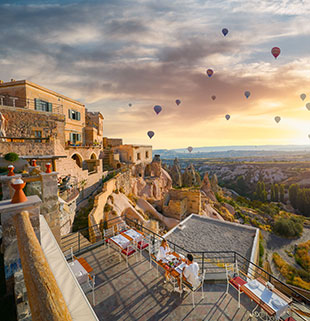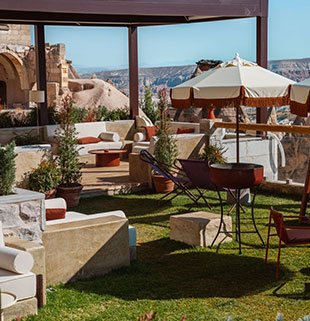Cappadocia, a region in the heart of Central Turkey, is more than just a tourist hotspot; it’s a living museum steeped in history that spans several millennia and numerous empires. From the Hittites to the Republic of Turkey, the land now known as Cappadocia has played host to a fascinating array of cultures and peoples.
The Historical Landscape of Cappadocia
The name Cappadocia derives from the Persian term ‘Katpatuka’, which means ‘the land of beautiful horses’. Established boundaries of Cappadocia have shifted over centuries, extending from the Black Sea to the Taurus Mountains at different times in history. Today, what we know as Cappadocia covers an area touching five Turkish provinces: Kayseri, Nevşehir, Kırşehir, Aksaray, and Niğde, encapsulating a region rich in natural and historical treasures.
The Empires of Cappadocia
The region’s history begins with the ancient Hittites, followed by the Eastern Mushki, and later, the Persians who set the stage for Cappadocia’s strategic importance. The fall of the Persian Empire to Alexander the Great brought a significant shift, eventually leading to Cappadocia’s status as a kingdom under Ariarathes I until the Roman takeover in 17 AD. The Roman, and subsequently Byzantine control, lasted until the arrival of the Seljuks post the battle of Manzikert in 1071, who introduced distinctive architectural styles such as caravanserais that are still evident in the region today.
The Influence of Christianity and Islam
Cappadocia holds a special place in Christian history. The early Christians found refuge in its cave communities, escaping persecution. The Cappadocian Fathers—Basil the Great, Gregory of Nazianzus, and Gregory of Nyssa—were instrumental in shaping early Christian theology and establishing monastic communities that endured for centuries. With the Seljuks, Islam took a firm hold, seen in the numerous mosques and madrasas that enrich the region’s cultural landscape.
Modern Cappadocia and the Legacy of Empires
Post the Ottoman Empire and following the Turkish War of Independence, Cappadocia emerged within the modern Republic of Turkey. The region’s complex history of overlapping cultures and shifting borders has left a lasting legacy, making it a unique blend of the past and present. The creation of Nevşehir, which evolved from a small village into a bustling city under Damat Ibrahim Pasha, symbolizes the ongoing transformation of Cappadocia.
Visiting Cappadocia Today: Things to Do and See
Today’s Cappadocia is renowned for its otherworldly landscape of fairy chimneys and rock formations. Things to do in Cappadocia range from hot air balloon rides offering spectacular aerial views, exploring ancient underground cities like Derinkuyu, to trekking through historic valleys. The region’s rich history is complemented by vibrant cultural experiences, from pottery workshops in Avanos to tasting local Anatolian wines.
How to Get to Cappadocia and the Best Time to Visit
Visitors wondering how to get to Cappadocia can fly into Nevşehir or Kayseri airports from major Turkish cities. The best time to visit Cappadocia is during the spring and fall when the weather is mild, perfect for outdoor activities and exploring the region’s natural beauty.
Cappadocia’s history is a testament to human endurance and creativity. As you wander through its ancient landscapes, consider the legacies of the empires that shaped this region, and enjoy the captivating beauty that has drawn travelers here for thousands of years.
FAQs for Cappadocia
Visitors should wear comfortable shoes and clothing suitable for both hiking and cooler underground conditions. It’s also recommended to respect the historical and cultural significance of the sites by adhering to local guidelines and restrictions.
What is the origin of the name ‘Cappadocia’?
The name Cappadocia originates from the Persian term ‘Katpatuka’ which means ‘the land of beautiful horses’. It reflects the region’s historical significance as a major equine center under Persian rule.
How old is Cappadocia, and who were its earliest inhabitants?
The human history of Cappadocia stretches back thousands of years, with its earliest known inhabitants being the Hittites around the 18th century BC. Subsequently, the region was controlled by various empires including the Persians, Romans, and Byzantines.
What are the must-visit historical sites in Cappadocia?
Must-visit sites include the Göreme Open-Air Museum, known for its rock-hewn churches and frescoes; the underground cities of Derinkuyu and Kaymaklı; and Uçhisar Castle, offering panoramic views of the landscape.
Can you explain the significance of the underground cities in Cappadocia?
The underground cities, such as Derinkuyu and Kaymaklı, were used historically for protection against invaders. These multi-level complexes included living spaces, food storage, and places of worship, showcasing an impressive use of engineering and architecture to ensure survival.
What is the best time of year to visit Cappadocia for historical tours?
The best times to visit Cappadocia for historical tours are during the spring (April to June) and autumn (September to November) when the weather is mild and conducive to exploring the outdoor and underground sites.
How did Christianity influence Cappadocia?
Christianity had a profound influence on Cappadocia, particularly visible in the region’s early churches and monastic communities. The Cappadocian Fathers, significant Christian theologians, helped develop Christian doctrine and established a strong monastic presence in the 4th century.
What role did the Seljuks and Ottomans play in Cappadocia’s history?
The Seljuks introduced Islamic architecture and culture to Cappadocia in the 11th century, including the caravanserais used by silk road traders. Later, the Ottomans incorporated Cappadocia into their empire, further enriching its cultural landscape and leaving behind many historical mosques and schools.
Are there any cultural traditions in Cappadocia that date back to ancient times?
Yes, one of the enduring cultural traditions is pottery, particularly in the town of Avanos. This craft uses red clay sourced from the Halys River and dates back to the Hittite period, continuing to be a significant aspect of local heritage.
How accessible are Cappadocia’s historical sites for tourists?
Most historical sites in Cappadocia are quite accessible to tourists. There are guided tours available that offer transportation and explanations in multiple languages, making it easy for visitors to explore the region’s rich history.
What should visitors keep in mind while exploring Cappadocia’s historical sites?
Visitors should wear comfortable shoes and clothing suitable for both hiking and cooler underground conditions. It’s also recommended to respect the historical and cultural significance of the sites by adhering to local guidelines and restrictions.
Frequently Asked Questions
-
What is the origin of the name 'Cappadocia'?
The name 'Cappadocia' comes from the Persian term 'Katpatuka', which means 'the land of beautiful horses'. This reflects its significance as a major equine center under Persian rule.
-
Who were the earliest known inhabitants of Cappadocia?
The earliest known inhabitants of Cappadocia were the Hittites around the 18th century BC.
-
What are some must-visit historical sites in Cappadocia?
Key historical sites include the Göreme Open-Air Museum, the underground cities of Derinkuyu and Kaymaklı, and Uçhisar Castle.
-
What is the significance of the underground cities in Cappadocia?
The underground cities like Derinkuyu and Kaymaklı were developed for protection against invaders, featuring extensive multi-level complexes with amenities for prolonged periods of habitation.









